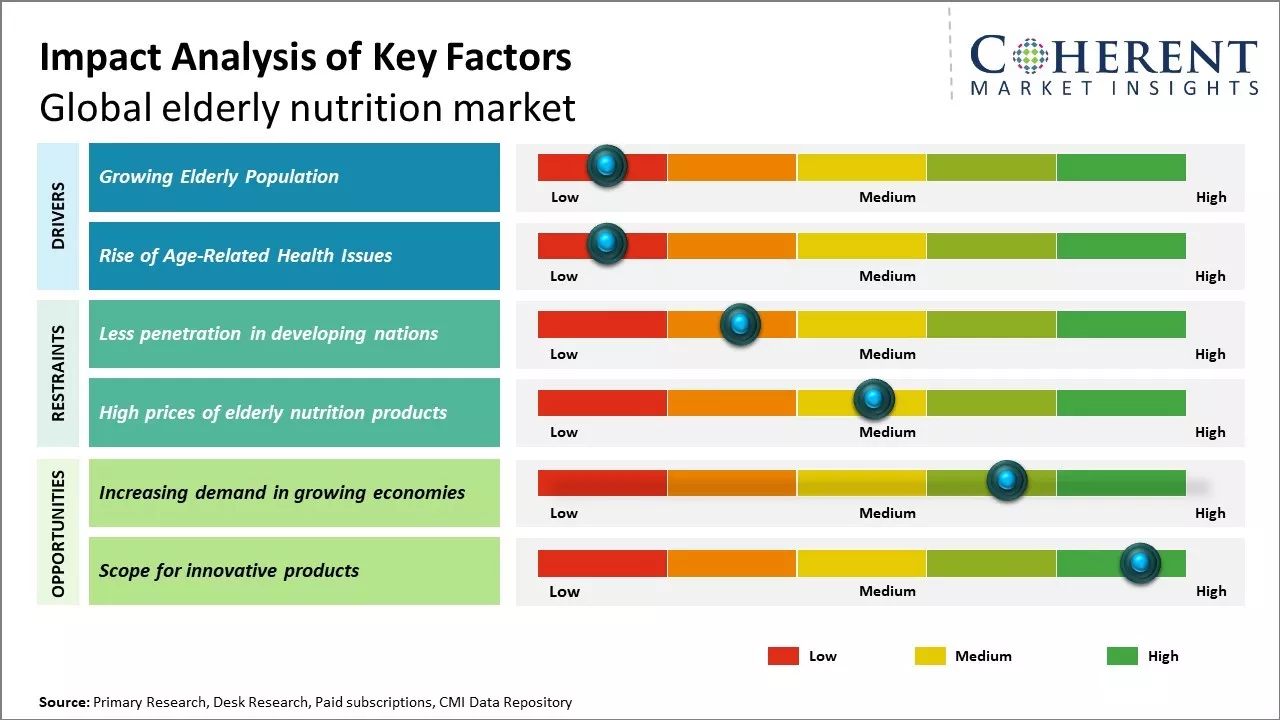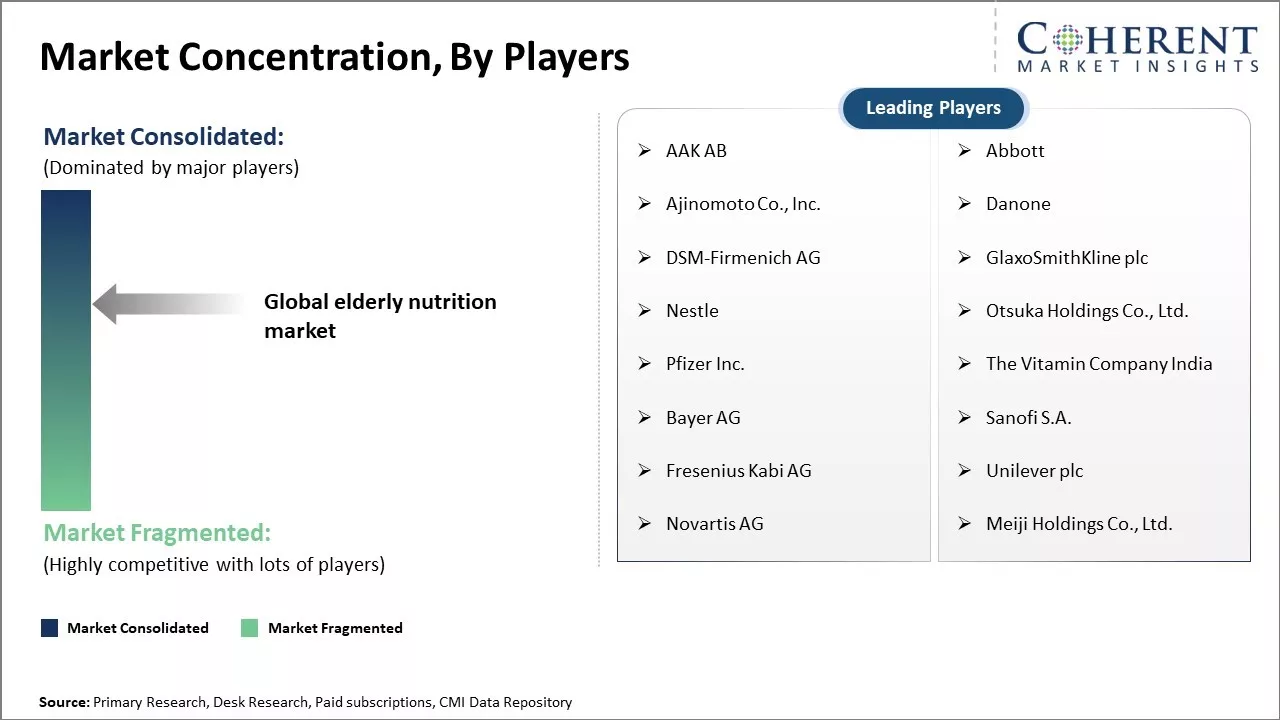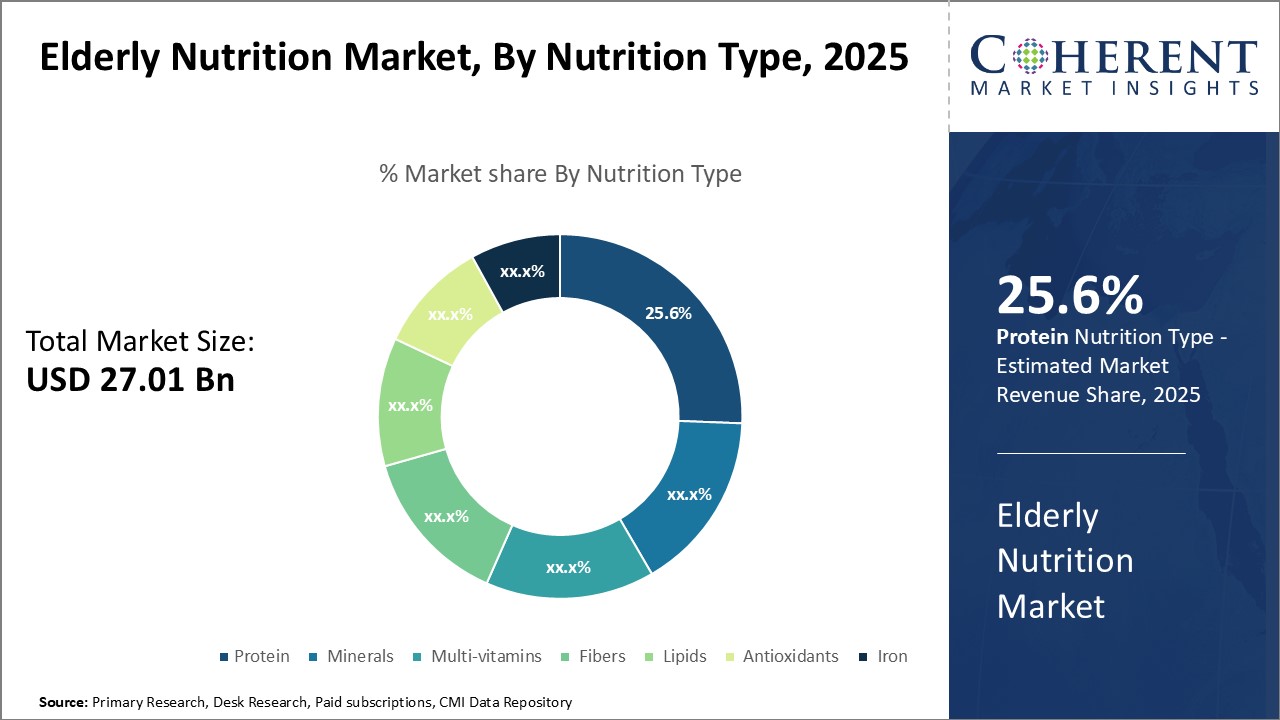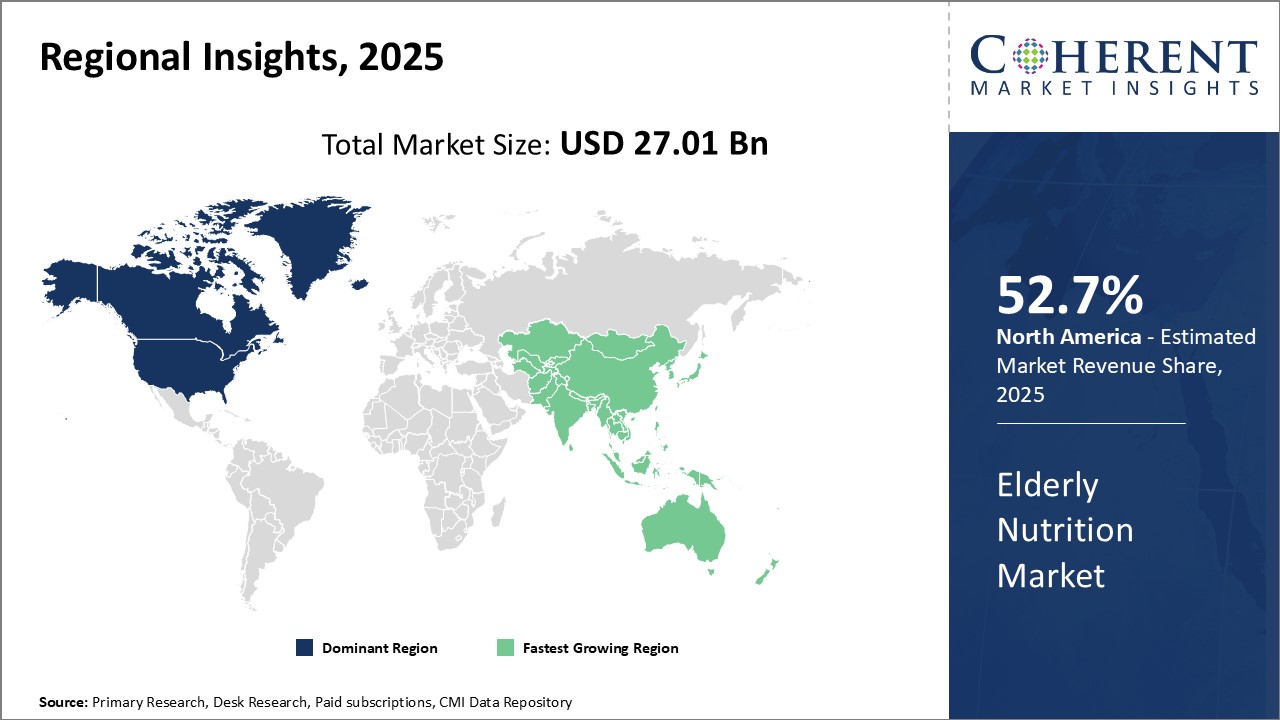Global elderly nutrition market is estimated to be valued at USD 27.01 Bn in 2025 and is expected to reach USD 43.11 Bn by 2032, exhibiting a compound annual growth rate (CAGR) of 6.9% from 2025 to 2032.

Discover market dynamics shaping the industry: Request sample copy
Rising aging population across major economies can boost demand for various elderly nutrition products. Growing awareness about the importance of maintaining proper nutritional diet among the elderly to stay healthy can also drive the market growth. Innovation and new product launches catering to the changing needs and preferences of the elderly demographics can offer business opportunities for the market players. However, high costs associated with some specialized elderly nutrition products can hamper the market growth. Increased focus on preventive healthcare and wellness among the aging population worldwide can offer growth opportunities for global elderly nutrition market.
Growing Elderly Population
Growing elderly population can drive the market growth. According to the United Nations, the number of people aged 60 years and older is expected to double by 2050 and reach nearly 2.1 billion people globally. As life expectancies increase around the world due to advancements in public health and medicine, people are living longer than ever before. As people live longer lives into their senior years, nutritional needs and requirements change with age. Older adults often experience a loss of appetite and changes in taste and smell, which can negatively impact their dietary intake and nutritional well-being. Many people also live with chronic health conditions like diabetes, heart disease or cancer that necessitate special diets. Due to growing aging population worldwide, there is huge demand for easy-to-consume foods and beverages specially formulated to meet the macronutrient and micronutrient needs of seniors. For instance, in September 2023, according to India Ageing Report, released by UNFPA, United Nations Population Fund, reveals critical insights into India's elderly population. It highlights a rapid growth rate of 41% among the elderly, projecting that by 2050, these will constitute over 20% of the total population. Economic challenges are stark, with more than 40% of elderly in the poorest wealth quintile and nearly 18.7% living without income, impacting their quality of life and healthcare access. By 2046, the elderly population is expected to surpass children aged 0-15 years. The report also notes gender disparities, with women generally having higher life expectancy at 60 and 80 years as compared to men, especially pronounced in states like Himachal Pradesh and Kerala in India.

Get actionable strategies to beat competition: Request sample copy
Rise of Age-Related Health Issues
As age of people increases, these people become more susceptible to various health issues. Conditions like arthritis, osteoporosis, hypertension, dementia and impaired mobility are increasingly prevalent among the elderly people. According to medical research, nutritional deficiencies and an inadequate diet can exacerbate or accelerate the progression of many age-related diseases and disabilities. Maintaining good nutrition help seniors to manage their health conditions better and live independently for longer. This boosts demand for fortified foods and supplements that provide antioxidants, vitamins, minerals, proteins and other important nutrients that are clinically proven to support cognitive function, bone and muscle health, heart health, blood sugar control and more. Increasing health challenges closely linked to aging can boost demand for customized nutrition solutions tailored to the specific illness management needs of older adults worldwide.
Key Takeaways from Analyst:
Global elderly nutrition market growth is driven by rising geriatric population worldwide who are prone to chronic diseases and age-related nutritional deficiencies. By 2050, over 1.5 billion people will be aged 65 years and above. This vast aging population base will require nutritional support to maintain health and quality of life. However, pricing pressure faced by manufacturers can hamper the market growth. As the majority of elderly citizens are retirees living on fixed incomes, these seek the most affordable products. This may restrict companies' abilities to regularly hike prices. Cultural attitudes around nutrition and aging can also hamper the market growth as some communities still view malnutrition as an inevitable part of aging.
Growing awareness about specific nutrient needs of older population and role of balanced diet in dealing with age-related health issues can drive the market growth. Rising acceptance of nutritional shakes and snack products for elderly as convenient supplements can also offer growth opportunities. Asia Pacific region dominates the market currently and is expected to witness highest gains in the upcoming decade due to sharp rise in aging populations in China and India. North America holds significant share due to early adoption of healthy aging concepts. Europe follows next driven by favorable policy support for elderly wellbeing in countries like Germany, France and U.K.
Market Challenges: Less penetration in developing nations
Access to proper nutrition and healthcare is a challenge for the elderly population in many developing nations. Poverty, lack of social security, inadequate health infrastructure and lack of awareness can hamper uptake of elderly nutrition products. According to the United Nations Population Fund Data in 2021, nearly 89% of the world's elderly population will be living in developing countries by 2050. However, a major section of this demographic does not have the financial means or access to purchase supplements, formulations or packaged food items tailored for their nutritional needs. This significantly curbs the market potential for elder nutrition manufacturers looking to expand globally. Even where the supply chains have reached, cultural preferences and traditional diets continue to override medical advice in some regions. Affordability emerges as a massive roadblock especially for those suffering from chronic age-related diseases that require custom blended nutrition. Lack of public healthcare support for the aged people exacerbates medical conditions and increases malnutrition risks. As per data from World Health Organization, every year, over 3 million deaths among the elderly can be attributed to inadequacies in diet and healthcare access in developing nations.
Market Opportunities: Increasing demand in growing economies
Rising demand for elderly nutrition products in many developing economies due to significant changes in demographics and lifestyles can offer market growth opportunities. As life expectancy rises globally and population ages, more people are now living longer after 60 years of age. Countries like China and India with huge geriatric population pools are witnessing growth. As per UN population data, number of elderly people is projected to double in India by 2050. This burgeoning elderly demographic in developing world can offer opportunity for nutrition companies. Traditionally, elderly people relied on home-cooked meals and local diets. However, modern lifestyles have increased health issues and nutrition deficiencies. Rising incomes also allow for more discretionary spend on health and wellness. Therefore, there is a growing appetite for specially formulated elderly nutrition products that address issues like malnutrition, bone & muscle loss, diabetes, and others. Several international non-profits like WHO are aggressively promoting awareness about benefits of healthy aging through balanced diets, supplements and customised meals. Local players as well as global giants are keenly watching these emerging markets and customising their offerings to suit local price points and tastes. They are introducing small packages, mixing traditional flavors with nutrition-rich ingredients to make products more palatable for the elderly.

Discover high revenue pocket segments and roadmap to it: Request sample copy
By Nutrition Type- Protein powers aging bodies
In terms of nutrition type, protein segment is estimated to contribute the highest market share of 25.6% in 2025, owning to the vital role it plays in promoting health and physical functioning among the elderly population. Protein is essential for preserving muscle mass and strength as people ages. It also supports bone health and immune function. For older adults, maintaining sufficient intake of high-quality protein is associated with benefits such as reduced risk of frailty, falls, and disability. Protein-rich foods like nuts, legumes, dairy, poultry, and seafood are widely recommended for seniors due to their blend of protein, vitamins, and minerals. With aging, muscle mass diminishes naturally without adequate protein intake to offset this effect. Therefore, protein forms a cornerstone of nutritional strategies and dietary guidelines aimed at supporting healthy aging, mobility, and independent living among the elderly.
By Application- Managing diabetes through nutrition
In terms of application, diabetes segment is estimated to contribute the highest market share of 20.8% in 2025 due to its high prevalence among senior citizens and the role of diet in managing this condition. The incidence of diabetes rises steeply with age and it poses serious health risks for older adults, if left unmonitored and untreated. Nutrition therapy is a key component of diabetes self-management. It helps control blood sugar levels and protect against diabetes complications. For older diabetics, selecting foods with balanced macronutrients and regulating portion sizes and meal timing are important facets of diet. Focus on fiber-rich whole grains, lean proteins, low glycemic load carbs, healthy fats, and produce supports optimal blood sugar control.
By Distribution Channel- Trusted healthcare avenues
In terms of distribution channel, hospital pharmacy segment is estimated to contribute the highest market share of 40.6% in 2025, owing to seniors' elevated health needs and reliance on professional medical advice. As people age, managing nutritional requirements becomes more complex in the context of multiple medications, existing diseases, and declining organ functions. Hospital pharmacists are well-positioned to provide personalized guidance on nutrition and drug interactions considering a patient's full clinical profile and treatment history. Their recommendations are valued due to pharmacists' specialist knowledge and hospitals' image as trusted healthcare hubs. For vulnerable elderly dealing with serious illnesses, obtaining supplements within hospital settings under physician oversight offers reassurance.

Need a Different Region or Segment? Customize now
North America represents the largest regional market for elderly nutrition globally with an estimated market share of 52.7% in 2025. The U.S., in particular, has witnessed significant rise in demand for specialized nutritional supplements and healthcare products for the aging population. Strong presence of leading manufacturers and retailers in the region has enabled easy availability of a wide variety of options. Furthermore, the presence of advanced healthcare infrastructure and higher healthcare spending in the country makes elderly nutrition products more accessible. Rising prevalence of age-related chronic conditions among the baby boomer generation can drive the market growth.
North American manufacturers are investing heavily in new product development and formulations to meet the unique and evolving requirements of the elderly. These are launching products fortified with additional vitamins, minerals, and other necessary nutrients required by older consumers. Manufacturers are also offering more options for aging individuals with specific health conditions like diabetes through tailored nutritional products. The emphasis on innovation makes available globally competitive products to both domestic and international customers.
The Asia Pacific region has emerged as one of the fastest growing markets for elderly nutrition globally. Rising geriatric population, growing economies, and increasing healthcare expenditure in countries like China and Japan can drive the market growth. Cultural preference for multi-generational living also supports supportive purchasing of nutrition products by younger family members. Unlike developed Western markets, Asia Pacific presents growth opportunities through rising disposable incomes and a growing middle class. Local players as well as global brands are expanding their presence through collaborations with regional distributors and private label partnerships to cater to rising demand from diverse local markets.
Elderly Nutrition Market Report Coverage
| Report Coverage | Details | ||
|---|---|---|---|
| Base Year: | 2024 | Market Size in 2025: | USD 27.01 Bn |
| Historical Data for: | 2020 To 2024 | Forecast Period: | 2025 To 2032 |
| Forecast Period 2025 to 2032 CAGR: | 6.9% | 2032 Value Projection: | USD 43.11 Bn |
| Geographies covered: |
|
||
| Segments covered: |
|
||
| Companies covered: |
AAK AB, Abbott, Ajinomoto Co., Inc., Danone, DSM-Firmenich AG, GlaxoSmithKline plc, Nestle, Otsuka Holdings Co., Ltd., Pfizer Inc., The Vitamin Company India, Bayer AG, Sanofi S.A., Fresenius Kabi AG, Unilever plc, Novartis AG, Meiji Holdings Co., Ltd. |
||
| Growth Drivers: |
|
||
| Restraints & Challenges: |
|
||
Uncover macros and micros vetted on 75+ parameters: Get instant access to report
Share
Share
About Author
Ghanshyam Shrivastava - With over 20 years of experience in the management consulting and research, Ghanshyam Shrivastava serves as a Principal Consultant, bringing extensive expertise in biologics and biosimilars. His primary expertise lies in areas such as market entry and expansion strategy, competitive intelligence, and strategic transformation across diversified portfolio of various drugs used for different therapeutic category and APIs. He excels at identifying key challenges faced by clients and providing robust solutions to enhance their strategic decision-making capabilities. His comprehensive understanding of the market ensures valuable contributions to research reports and business decisions.
Ghanshyam is a sought-after speaker at industry conferences and contributes to various publications on pharma industry.
Missing comfort of reading report in your local language? Find your preferred language :
Transform your Strategy with Exclusive Trending Reports :
Frequently Asked Questions
Joining thousands of companies around the world committed to making the Excellent Business Solutions.
View All Our Clients
US Reciprocal Tax Impact Analysis On Elderly Nutrition Market
Stay updated on tariff changes with expert insights and timely information